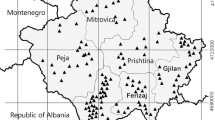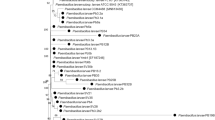Abstract
In our study, honey samples of different global and local origins were tested for antibiotic residues as well as the presence of the bacterium Paenibacillus larvae, the causative agent of the honeybee disease American foulbrood (AFB). 30 German and 47 imported non-European honeys were analyzed for sulfonamides, trimethoprim, tetracyclines, macrolides, lincomycin and chloramphenicol. 22 of the imported honeys contained residues (in most cases more than one), whereas 29 of the 30 German samples were free of residues. Sulfamethoxazole was the most frequently found antibiotic (often combined with trimethoprim). Almost all of the analyzed honeys from Argentina, China and Canada were AFB-positive (category I and II), whereas only five German honeys were AFB-positive. A correlation of present antibiotics and AFB spores was not found. For investigating putative relations between imported honeys and AFB cases in the area of Hamburg, genomic fingerprinting by PCR-amplification of repetitive DNA elements of the bacterial isolates was performed. The study shows that distinct genotypes of P. larvae are prevalent in samples of different geographical origin. AFB isolates of imported honeys differ from the predominant genotype in the area of Hamburg. Furthermore, the prevalent genotype in Hamburg was characterized by the absence of the iC9-fragment which was shown to be linked to virulence of P. larvae strains.

Similar content being viewed by others
Notes
Two of the three honey samples from Niedersachsen were obtained from the same apiarist.
References
Alippi AM, Aguilar OM (1998) Characterization of isolates of Paenibacillus larvae subsp. larvae from diverse geographical origin by the polymerase chain reaction and BOX primers. J Invertebr Pathol 72:21–27
Altschul SF, Gish W, Miller W, Myers EW, Lipman DJ (1990) Basic local alignment search tool. J Mol Biol 215:403–410
Boecking O (2008) Bienen-Krankheitsprophylaxe- wie sich Honigbienen der Krankheiten erwehren können und welche imkerlichen Möglichkeiten zur Vorsorge bestehen, dies zu unterstützen. J Verbr Lebensm 3:435–440
Bogdanov S (2006) Contaminants of bee products. Apidologie 37:1
Bogdanov S, Fluri P (2000) Honigqualität und Antibiotikarückstände. Schweiz Bienenzeitg 123:407–410
de Graaf DC, De Vos P, Heyndrickx M, Van Trappen S, Peiren N, Jacobs FJ (2006) Identification of Paenibacillus larvae to the subspecies level: an obstacle for AFB diagnosis. J Invertebr Pathol 91:115–123
Dingman DW, Stahly DP (1983) Medium promoting sporulation of Bacillus larvae and metabolism of medium components. Appl Environ Microbiol 46:860–869
Ellis JD, Munn PA (2005) The worldwide health status of honey bees. Bee World 86:88–101
Fries I, Lindström A, Korpela S (2006) Vertical transmission of American foulbrood (Paenibacillus larvae) in honey bees (Apis mellifera). Vet Microbiol 114:269–274
Genersch E (2010) American Foulbrood in honeybees and its causative agent, Paenibacillus larvae. J Invertebr Pathol 103:510–519
Genersch E, Otten C (2003) The use of repetitive element PCR fingerprinting (rep-PCR) for genetic subtyping of German field isolates of Paenibacillus larvae subsp. larvae. Apidologie 34:195–206
Genersch E, Forsgren E, Pentikäinen J, Ashiralieva A, Rauch S, Kilwinski J, Fries I (2006) Reclassification of Paenibacillus larvae subsp. pulvifaciens and Paenibacillus larvae subsp. larvae as Paenibacillus larvae without subspecies differentiation. Int J Syst Evol Microbiol 56:501–511
Gramm U (2010) Border inspection post, Hamburg, Germany (unpublished)
Herold E (1990) Neue Imkerschule. Ehrenwirth Verlag, Munich
Heyndrickx M, Vandemeulebroecke K, Hoste B, Janssen P, Kersters K, De Vos P, Logan N, Ali N, Berkeley R (1996) Reclassification of Paenibacillus (formerly Bacillus) pulvifaciens (Nakamura 1984) Ash et al. 1994, a later subjective synonym of Paenibacillus (formerly Bacillus) larvae (White 1906) Ash et al. 1994, as a subspecies of P. larvae, with emended descriptions of P. larvae as P. larvae subsp. larvae and P. larvae subsp. pulvifaciens. Int J Syst Bacteriol 46:270–279
Institut für Hygiene und Umwelt (2009) Aktuelle Themen aus den Jahren 2008/2009. Institut für Hygiene und Umwelt, Hamburg
Katznelson H (1950) Bacillus pulvifaciens (n. sp.), an organism associated with powdery scale of honeybee larvae. J Bacteriol 59:153–155
Lila Liste (2011) Remedia ad us. vet., 25. Auflage, Delta Verlag GmbH, Berlin
Lindström A, Korpela S, Fries I (2008a) Horizontal transmission of Paenibacillus larvae spores between honey bee (Apis mellifera) colonies through robbing. Apidologie 39:1–8
Lindström A, Korpela S, Fries I (2008b) The distribution of Paenibacillus larvae spores in adult bees and honey and larval mortality, following the addition of American foulbrood diseased brood or spore-contaminated honey in honey bee (Apis mellifera) colonies. J Invertebr Pathol 99:82–86
Loncaric I, Derakhshifar I, Oberlerchner JT, Köglberger H, Moosbeckhofer R (2009) Genetic diversity among isolates of Paenibacillus larvae from Austria. J Invertebr Pathol 100:44–46
Münstedt T, Rademacher E, Petz M (2002) Chlortetracycline and oxytetracycline residues in honey after administration to honey-bees. In: Proceedings 4th international symposium on hormone and drug residue analysis, Antwerpen, Belgium, p 147
Neuendorf S, Hedtke K, Tangen G, Genersch E (2004) Biochemical characterization of different genotypes of Paenibacillus larvae subsp. larvae, a honeybee pathogen. Microbiology 150:2381–2390
Peters M, Kilwinski J, Beringhoff A, Reckling D, Genersch E (2006) American foulbrood of the honey bee: occurrence and distribution of different genotypes of Paenibacillus larvae in the administrative district of Arnsberg (North Rhine-Westphalia). J Vet Med B 53:100–104
Prince S (2000) The basis of virulence of Paenibacillus larvae subsp. larvae the causative agent of American foulbrood in honeybees. PhD thesis, School of Biosciences, University of Wales, Cardiff, UK
Ratnieks FLW (1992) American foulbrood: the spread and control of an important disease of the honey bee. Bee World 73:177–191
Rauch S, Ashiralieva A, Hedtke K, Genersch E (2009) Negative correlation between individual-insect-level virulence and colony-level virulence of Paenibacillus larvae, the etiological agent of American foulbrood of honeybees. Appl Environ Microbiol 75:3344–3347
Reybroeck W (2003) Residues of antibiotics and sulphonamides in honey on the Belgian market. Apiacta 38:23–30
Ritter W (2003) Early detection of American foulbrood by honey and wax analysis. Apiacta 38:125–130
Schotte M, Just P (2006) Beurteilung von Sulfonamidrückständen in Honig. J Verbr Lebensm 1(Suppl 2):172–173
Sharman M, Thomas M (2009) Survey on use of veterinary medicinal products in third countries. The Food Environment Research Agency, York
Stackebrandt E, Goodfellow M (1991) Nucleic acid techniques in bacterial systematics. Wiley, Chichester
Ulakova V, Kiss E, Kusinova J, Silhar S (2008) Kinetics of degradation of oxytetracycline and tetracycline in honey. J Food Nutr Res 47(3):139
Versalovic J, Schneider M, de Bruijn FJ, Lupski JR (1994) Genomic fingerprinting of bacteria using repetitive sequence based PCR (rep-PCR). Methods Cell Mol Biol 5:25–40
Weisburg WG, Barns SM, Pelletier DA, Lane DJ (1991) 16S-ribosomal DNA amplification for phylogenetic study. J Bacteriol 173:697–703
White GF (1906) The bacteria of the apiary with special reference to bee disease. In: US Department of Agriculture (ed) Bureau of Entomology, Technical Series no. 14. Washington, DC, pp 1–50
Wilson WT (1971) Resistance to American foulbrood in honey bees. XI. Fate of Bacillus larvae spores ingested by adults. J Invertebr Pathol 17:247–255
Yue D, Nordhoff M, Wieler LH, Genersch E (2008) Fluorescence in situ hybridization (FISH) analysis of the interactions between honeybee larvae and Paenibacillus larvae, the causative agent of American foulbrood of honeybees (Apis mellifera). Environ Microbiol 10:1612–1620
Acknowledgments
We wish to thank the staff of the Veterinary Drugs Laboratory for excellent technical assistance.
Author information
Authors and Affiliations
Corresponding author
Electronic supplementary material
Below is the link to the electronic supplementary material.
Rights and permissions
About this article
Cite this article
Näumann, G., Mahrt, E., Himmelreich, A. et al. Traces of contamination–well preserved in honey. J. Verbr. Lebensm. 7, 35–43 (2012). https://doi.org/10.1007/s00003-011-0750-z
Received:
Accepted:
Published:
Issue Date:
DOI: https://doi.org/10.1007/s00003-011-0750-z




